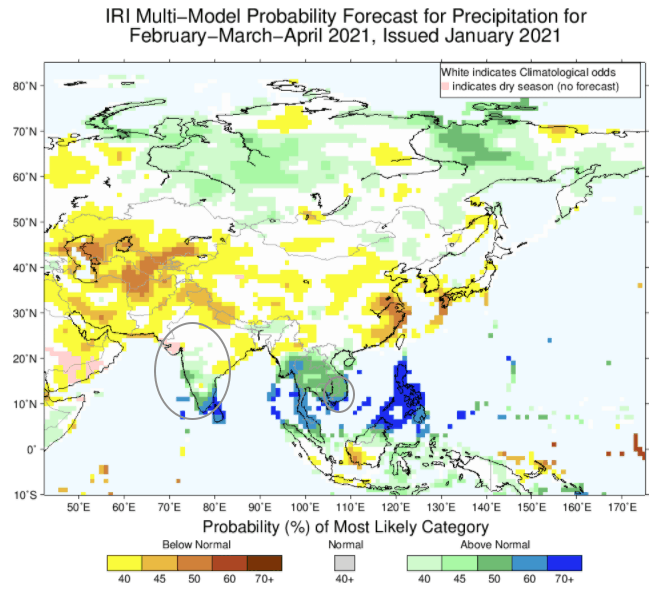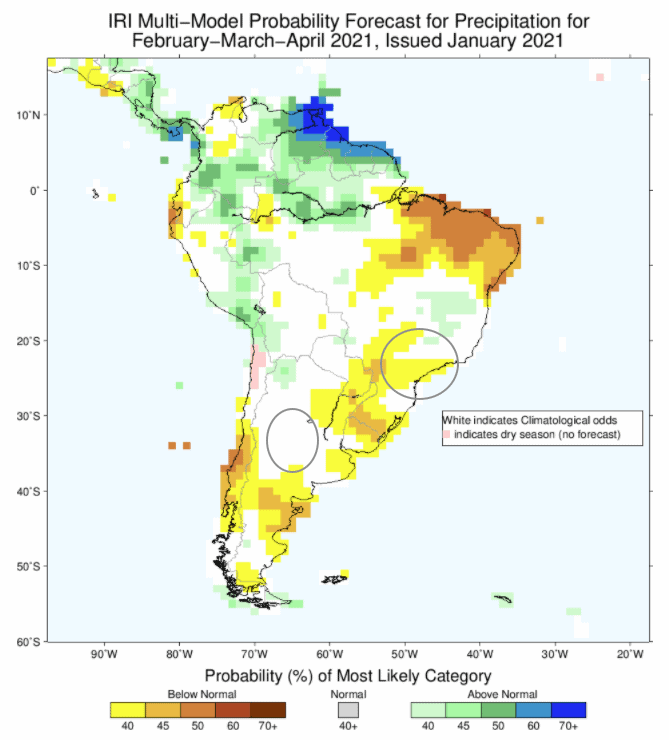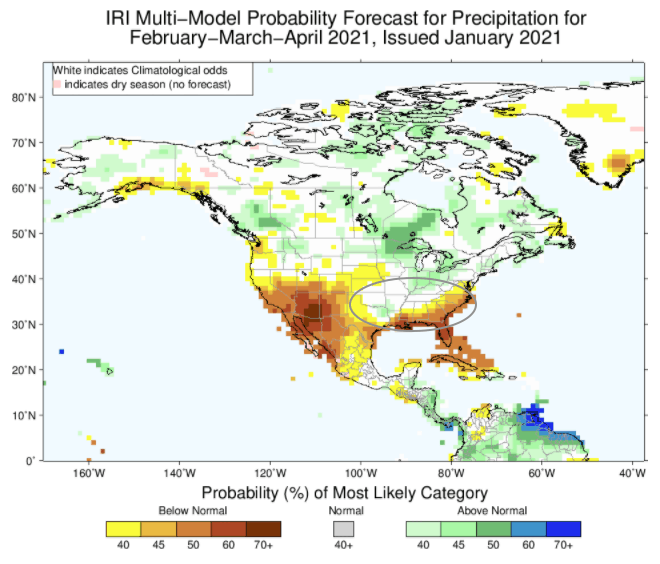What has happened so far?
First of all, let’s remember that La Niña is a climate event that corresponds to a cooling down of the sea surface temperature in a specific part of the Pacific Ocean, of more than 0.5°C during more than three consecutive months. The current La Niña event developed during the summer of 2020. The peak of the event seems to have been reached in the latest days of 2020. Current predictions forecast a slow return to a neutral phase of the ENSO indicators. La Niña will most likely dissipate during spring.
As mentioned in our previous posts on this subject, the weather of the past months in several regions of the world has been affected by La Niña:
Peanut regions:
- Severe drought affected Argentina during the local winter season, with severe effects on the crops. Fortunately, rainfalls occurred just at the start of the peanut planting period. Therefore, it only resulted in a slight delay in peanut plantings; but farmers managed to plant the full area considerably faster than usual, reducing the potential damages on the crop. Since then, the peanut region received little rainfall, less than usual but enough to limit damages on the crop.
- In Brazil, peanut producers usually await for the first rainfalls to start planting. But this year the rainfalls have been largely delayed, and therefore peanut plantings pushed back, in some areas, even up to 2 months.
- In the USA, the intensive hurricane season occurred by the end of the 2020 crop. Some crops have been damaged in southern Alabama, and Northern Florida but the rest of the crop was mostly spared. Only delays in the harvest were noticeable, but they did not impact the quality or quantity negatively.
- The northwest of India received heavy rainfalls, just before peanut harvest. This resulted in lower quality and considerable delays. Luckily, this was compensated by a more extensive area planted with peanuts this year.
Cashew regions:
- Some highly destructive typhoons landed in Vietnam between September and November. Most of them made landfall in the country’s central-eastern part, resulting in many material damages and human casualties. However, most of the cashew orchards are located in the south of the country and were spared by these terrible weather events.
Contrary to what is usually believed, ENSO phenomena (La Niña and El Niño), are not only negative or only positive. They have diverse consequences in various places of the world: some regions experience more intense rainfalls while others are undergoing droughts.
Expectations for South America and South East Asia
La Niña is expected to dissipate within the coming months. Its effect on the weather and its consequences on the crops are now likely to be relatively mild for the crops developing in South America, Africa and Asia. Usually, during a La Niña event, the weather is impacted in South America and Southeastern Asia during the second half of the Gregorian calendar. Therefore, despite La Niña’s presence, few weather disruptions compared to usual are expected in the coming months.
However, in South America, since the planting rainfalls have, so far, been on the low side and the near-average rainfalls that are expected in the coming months might not be sufficient to ensure crops of good quantity and quality. In the peanut region in Argentina, located in the region of Cordoba, near-average rainfalls are forecasted. In Brazil, a small risk of below-average rainfall is present (see map on the right).
On the other hand, in the cashew producing regions in Vietnam and India, slightly above average rainfalls could be experienced (see map on the left). Nevertheless, the flowering of cashew trees in Vietnam has already made good progress. Even if rain falls during the dry season, the production should not be too severely affected.
On the other hand, in the cashew producing regions in Vietnam and India, slightly above average rainfalls could be experienced (see map on the left). Nevertheless, the flowering of cashew trees in Vietnam has already made good progress. Even if rain falls during the dry season, the production should not be too severely affected.
Expectations for North America
In the longer term, US farmers will start planting their peanut crop in April/May. However, in those regions, La Niña’s impact is more noticeable from October to April. Therefore, the phenomenon could have consequences on the coming American crop.
The International Research Institute for Climate and Society is forecasting drier weather than usual in the southern part of the US, a typical pattern during La Niña’s occurrence (see map on the right).
In a nutshell, the consequences of La Niña are mostly behind us. This season, the impact has been more prevalent for peanut crops than cashews, which seem to be developing well in the Northern hemisphere.








 Westplein 58
Westplein 58



 We use cookies to ensure you get the best experience on our website. For more information, please read our
We use cookies to ensure you get the best experience on our website. For more information, please read our